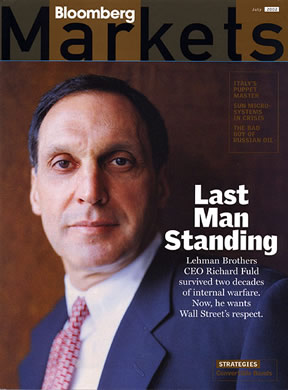
Books will be written about his all too human failure ...
Anyone
know why investment banks are failing?
Scan the papers / journals and you'll not find out.
As Paul Krugman
says, "And as the unknown unknowns have turned into known unknowns, the system has been experiencing postmodern bank runs."
I tend to concur, but there is more than just a run mentality at work. That's a symptom. What is the cause? If there is a list of causes, what are they and in what proportion? [There will be Congressional hearings ...]
One has to consider that the problems lay off balance-sheet, in the derivatives that have (a) soured or (b) turned into "loans", because there is no liquid market in the underlying.
On the other hand, CNBC is reporting that Lehman had marks on the "mortgage portfolio" way too high, even on the weekend. So, where was the SEC, then, over the past nine months? How much was that, in relation to their other problems. What's more, if that is all that was true, then truly the Fed should have considered a "portfolio workout" loan.
AN ORDERLY DESCENT INTO AN UNWANTED OUTCOMEI cannot believe that AIG's book of derivatives could just be allowed to collapse. Those yelling "no taxpayer bailouts" have to consider that the reduced competition and the reduced ability to lay off and price risk has consequences too, that may or may not rival "moral hazard".
As for Fed action, their task is not to "save institutions" but, perhaps, to save those parts of institutions that are key to keep the markets orderly and functioning.
That means a very politically difficult decision, in the current politico-regulatory, ideologically-driven environment: they have to draw a line and it cannot be an "on" or "off", they may have to "partially save" some organizations. Since no one will agree just where or how to draw that line, it's a thankless task, as are most of the other regulatory aspects and last resort lender aspects of the Fed. What's worse, it may not be possible to "legally" pull off such a manoeuvre - it's like doing a collateral reorganization, perhaps, on the fly, rather than through a prolonged bankruptcy proceeding.
NOT JUST CAPITAL NEEDED?
Following Krugman's comments, one has to wonder if post-modern tools aren't needed.
Rather than trying to run around finding additional capital, perhaps the "solution" is to do a complex, multi-party unwind/netting of derivatives trades, to the extent that those contracts are the "problem" (and again, it's hard to know what the real problems are...).
In other words, replensh capital (taxpayer supported, if needed) for the direct loans that went "bad", like straight subprime securities, and implement a "forced unwind" for various derivatives contracts, to prevent or secure "domino" problems associated with counterparty failure, if any.
Even if the derivatives risks are all concentrated with a few players who made bad bets, it may not be judged best let those institutions fail and draw as best a "firewall" around them as possible, rather than to force a systemic "solution" on all participating institutions. Of course, that might "reward" foolish and weak players, but that shortcoming might be easier to "manage" than the alternative, which is a total and prolongued restructuring of the financial sector, with higher long-term capital costs for the economy ...
[+/-] Show Full Post...
[+/-] Hide Full Post...

